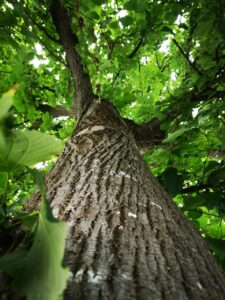APPLICATIONS OF TECHNOLOGY:
- Plant Physiology Research
- Ecosystem Management, Forestry Science
- Agriculture
ADVANTAGES:
- Lower cost than commercially available efflux (Es) measurement systems.
- Measures Es in real-time compared to static chambers that measure Es indirectly.
- Provides information on the short-duration growth rates of trees and plants and their environmental conditions, not possible with physical measurements.
BACKGROUND:
It is estimated that between 40% to 60% of CO2 fixed by plants is released by autotrophic respiration during tissue maintenance and growth processes. This represents a major source of CO2 in the atmosphere and is an important component of carbon cycling in terrestrial ecosystems. Although stems store the majority of carbon in ecosystems, a commercial system is not available to study the release of CO2 in real-time, and therefore little is known about how much CO2 is released by stems and how environmental variables and biological factors impact plant growth. Although plant growth is known to be highly sensitive to mild water stress, information on how plant growth changes during the night/day and throughout the seasons is poorly understood. Understanding the mechanisms that impact plant growth has major implications for predicting ecosystem carbon storage and cycling and the impact of climate change and species diversity on these processes.
Current methods to measure stem respiration (Es) in forest ecosystems have major limitations, including lack of continuous data, underestimation of efflux rates, leaks, malfunctioning due to condensation, and operational complexity optimized for soils rather than stems. Thus, the industry needs a low-cost, commercially available system for real-time stem Es monitoring across scales from growth chamber, greenhouse, to challenging field studies in natural and managed ecosystems.
TECHNOLOGY OVERVIEW:
A Berkeley Lab researcher has developed a portable, low power, real-time stem respiration measurement system. The system utilizes a 3D printed dynamic stem chamber, two infrared gas analyzer (IRGA) for continuous ambient and stem air CO2 concentration observations, and a battery enclosed within a waterproof casing. Advantages of this system include:
- control over flow rate through the stem chamber;
- eliminates the need for a pump; and
- eliminates water condensation issues by removing water vapor prior to CO2 analysis.
The researcher has validated this system in the field with a 24-hr quantification of stem CO2 efflux in harsh, tropical environments. Even after continuous measurements on 3-7 different tree species during a one week span, the 400 ppm calibration/match procedure of the IRGA used showed low drift of the IGRAs with the CO2 offset determined by weekly calibrations less than 5 ppm.
Results obtained by the portable stem respiration system show consistency with studies on diurnal stem growth patterns of field trees based on physical real-time measurements of stem diameter; that is, Es can be suppressed during the day relative to the night. This suggests that real-time Es patterns can be used to understand diurnal growth patterns of plants and the environmental and biological conditions that promote growth.
DEVELOPMENT STAGE:
Proven Principle, field-tested in the remote central Amazon forest under high rain conditions.
PRINCIPAL INVESTIGATORS:
- Kolby Jardine
FOR MORE INFORMATION:
Development of a lightweight, portable, waterproof, and low power stem respiration system for trees
STATUS:
Patent Pending
SEE THESE OTHER BERKELEY LAB TECHNOLOGIES IN THIS FIELD:
Soil Imaging with Neutrons to Measure Carbon and Other Elements 2021-117

